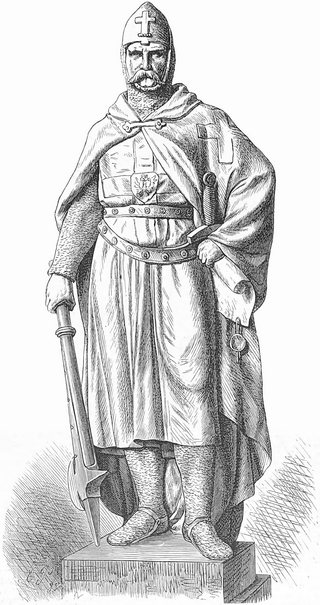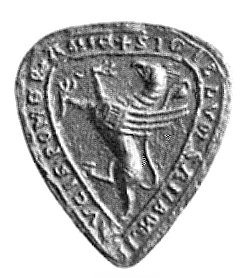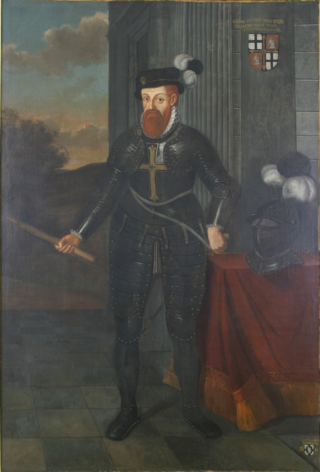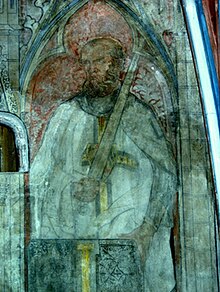
The Teutonic Order is a Catholic religious institution founded as a military society c. 1190 in Acre, Kingdom of Jerusalem. The Order of Brothers of the German House of Saint Mary in Jerusalem was formed to aid Christians on their pilgrimages to the Holy Land and to establish hospitals. Its members have commonly been known as the Teutonic Knights, having historically served as a crusading military order for supporting Catholic rule in the Holy Land and the Northern Crusades during the Middle Ages, as well as providing military protection for Catholics in Eastern Europe.

The Livonian Order was an autonomous branch of the Teutonic Order, formed in 1237. From 1435 to 1561 it was a member of the Livonian Confederation.

Pomerelia, also known as Eastern Pomerania, Vistula Pomerania, and also before World War II as Polish Pomerania, is a historical sub-region of Pomerania on the southern shore of the Baltic Sea in northern Poland.

Swietopelk II, also Zwantepolc II or Swantopolk II,, sometimes known as the Great, was the ruling Duke of Pomerelia-Gdańsk from 1215 until his death. He was the first member of the Samborides to style himself dux from 1227 onwards.

Hermann von Salza was the fourth Grand Master of the Teutonic Knights, serving from 1210 to 1239. A skilled diplomat with ties to the Frederick II and the Pope, Hermann oversaw the expansion of the military order into Prussia.
Gerhard von Malberg was the sixth Grand Master of the Teutonic Order, serving from c. 1241 to 1244. He was forced to resign from the office, and he does not appear in lists of the order's Grand Masters compiled in the 15th and 16th centuries.

Balga was a medieval castle of the Teutonic Knights in Kaliningrad Oblast, Russia. The castle ruins are located on the shore of the Vistula Lagoon, north of Mamonovo in the Pogranichny municipality of Bagrationovsky District, about 30 km (19 mi) southwest of Kaliningrad.

The grand master of the Teutonic Order is the supreme head of the Teutonic Order. It is equivalent to the grand master of other military orders and the superior general in non-military Roman Catholic religious orders. Hochmeister, literally "high master", is only used in reference to the Teutonic Order, as Großmeister is used in German to refer to the leaders of other orders of knighthood.

Hans von Baysen or Jan Bażyński was a Prussian knight and statesman, leader of the Prussian Confederation and the first Polish governor of Royal Prussia.
Wilhelm von Urenbach was chosen as the Grand Master of the Teutonic Order in 1253 in opposition to Grand Master Poppo von Osterna, elected by the majority of the knights. He is considered a pretender to the title, as he was chosen by the pro-papal Guelph minority party.

The Prussian uprisings were two major and three smaller uprisings by the Old Prussians, one of the Baltic tribes, against the Teutonic Knights that took place in the 13th century during the Prussian Crusade. The crusading military order, supported by the Popes and Christian Europe, sought to conquer and convert the pagan Prussians. In the first ten years of the crusade, five of the seven major Prussian clans fell under the control of the less numerous Teutonic Knights. However, the Prussians rose against their conquerors on five occasions.

Polish–Teutonic Wars refer to a series of conflicts that took place between the Kingdom of Poland and the Teutonic Order, a medieval German military order with roots in the Baltic region. These wars occurred primarily during the 14th and 15th centuries and were characterized by territorial disputes, political maneuvering, and religious differences.

The city of Danzig (Gdańsk) was captured by the State of the Teutonic Order on 13 November 1308, resulting in a massacre of its inhabitants and marking the beginning of tensions between Poland and the Teutonic Order. Originally the knights moved into the fortress as an ally of Poland against the Margraviate of Brandenburg. However, after disputes over the control of the city between the Order and the King of Poland arose, the knights murdered a number of citizens within the city and took it as their own. Thus the event is also known as Gdańsk massacre or Gdańsk slaughter. Though in the past a matter of debate among historians, a consensus has been established that many people were murdered and a considerable part of the town was destroyed in the context of the takeover.

Hermann Balk, also known as Hermann von Balk or Hermann Balke, was a Knight-Brother of the Teutonic Order and its first Landmeister, or Provincial Master, in both Prussia and Livonia. From 1219 to 1227, he served as the Deutschmeister in the Order's Province of Alemannia. Balk led the crusaders during the Prussian Crusade and became Master of Prussia in 1230. From 1237 to 1238, he also served in the additional role as Master of Livonia.

Sambor II of Tczew was a duke of Pomerania and prince of Lubiszewo Tczewskie.

The Mongol Invasion of Poland from late 1240 to 1241 culminated in the Battle of Legnica, where the Mongols defeated an alliance which included forces from fragmented Poland and their allies, led by Henry II the Pious, the Duke of Silesia. The first invasion's intention was to secure the flank of the main Mongolian army attacking the Kingdom of Hungary. The Mongols neutralized any potential help to King Béla IV being provided by the Poles or any military orders.
Landmeister of Prussia was a high office in the Teutonic Order. The Landmeister administered the land of Prussia of the Teutonic Order. It was in existence as a separate office from 1230 to 1309, later being held in union with the office of Grand Master until 1525.
Dietrich von Grüningen was a Knights Templar, Landmeister in Livonia and Landmeister of Prussia and Deutschmeister of the Teutonic Order. One of the most outstanding figures of the Teutonic Order in the 13th century.

Burkhard von Hornhausen was from 1257 to 1260 Landmeister in Livonia of the Teutonic Order. He was the first commander and directed the construction of the Königsberg Castle.

Georg Hund von Wenkheim, or Georg Hundt von Wenkheim was the 40th Grandmaster of the Teutonic Knights, reigning from 1566 to his death 1572.


















